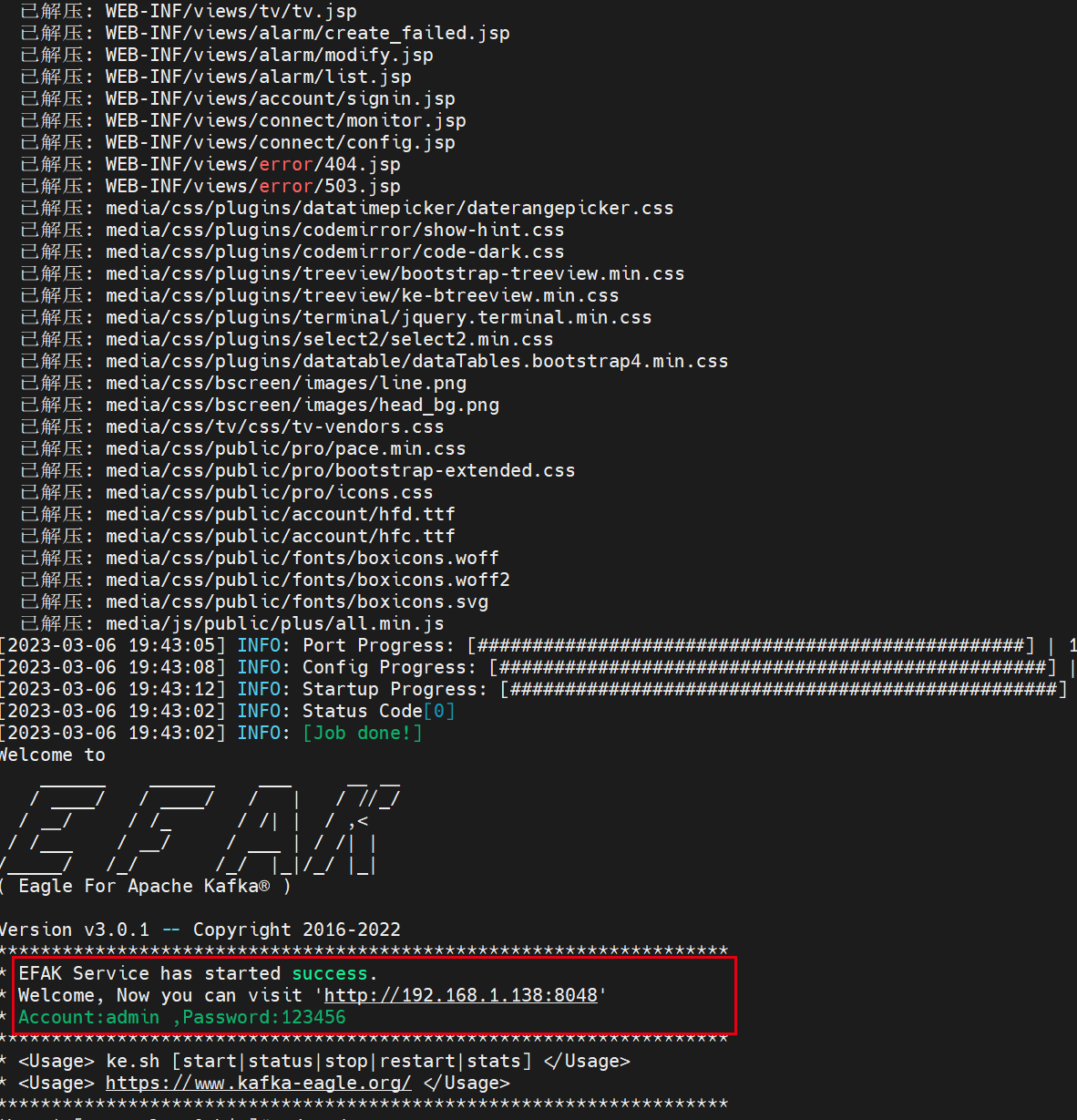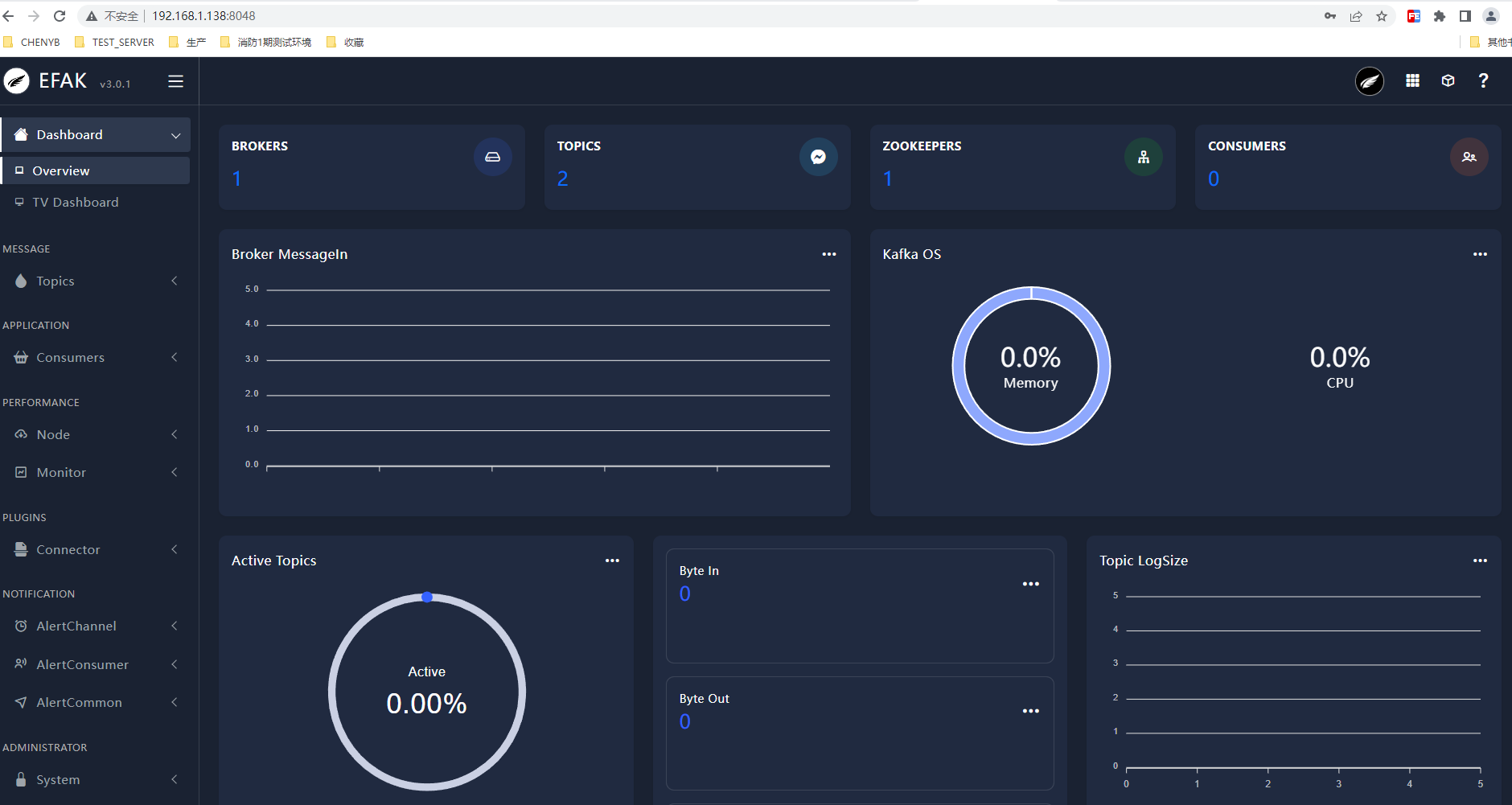SpringBoot整合Kafka(包含Kafka_2.12-3.3.1单节点安装,kafka可视化程序efka v3.0.1安装)
kafka安装
资源下载:
//解压
tar -zxvf /home/soft/kafka_2.12-3.3.1.tgz
//更名
mv kafka_2.12-3.3.1/ kafka 目录结构:进入 kafka目录后目录结构

配置kafka内嵌的zookeeper (位置:vim ./config/zookeeper.properties )注意端口号和存储地址
dataDir=/home/hzh04/Desktop/kafka/data-zookeeper
clientPort=2181启动zookeeper:
./bin/zookeeper-server-start.sh -daemon ./config/zookeeper.properties如果zookeeper需要开启kerberos认证需要给zookeeper.properties添加配置(demo中没有配置):
authProvider.1=org.apache.zookeeper.server.auth.SASLAuthenticationProvider
requireClientAuthScheme=sasl
jaasLoginRenew=3600000
修改kafka配置文件(位置:./config/server.properties)关于zookeeper相关配置与zookeeper保持一致:
# *** listeners & zookeeper.connect ***
listeners=PLAINTEXT://0.0.0.0:9092
zookeeper.connect=0.0.0.0:2181
advertised.listeners=PLAINTEXT://ip:9092
broker.id=1
num.network.threads=3
num.io.threads=8
socket.send.buffer.bytes=102400
socket.receive.buffer.bytes=102400
socket.request.max.bytes=104857600
log.dirs=/home/hzh04/Desktop/kafka/logs
num.partitions=1
num.recovery.threads.per.data.dir=1
offsets.topic.replication.factor=1
transaction.state.log.replication.factor=1
transaction.state.log.min.isr=1
log.retention.hours=168
log.retention.check.interval.ms=300000
zookeeper.connection.timeout.ms=18000
group.initial.rebalance.delay.ms=0启动kafka
./bin/kafka-server-start.sh ./config/server.properties查看java程序进程:jps

表示已经启动成功了
订阅测试(demo中测试主题为:kafka1):
消费者进入主题(topic):
./kafka-console-consumer.sh --bootstrap-server localhost:9092 --topic kafka1 --from-beginning
生产者进入主题(topic):
./kafka-console-producer.sh --broker-list localhost:9092 --topic kafka1 
表示已经能正常通讯了,kafka单节点搭建成功
如果kafka不能实现topic监听,就试着以下操作:
停止kafka服务;
停止zookeeper服务;
清除kafka配置文件(server.properties)中log.dirs=''路径下的文件,或者换个地址;
清除zookeeper配置(kafka原生zookeeper配置文件是:zookeeper.properties)文件中配置的dataDir=''路径下的文件,或者换个地址;
重新启动zookeeper、kafka;
efak(kafka管理工具)安装
资源下载:
下载tgz安装包:http://www.kafka-eagle.org/
解压完压缩包配置环境变量:
# 编辑环境变量
vim /etc/profile
export KE_HOME= /opt/software/kafka-eagle
PATH=$PATH:$KE_HOME/bin
# 刷新环境变量:
source /etc/profile修改配置(./conf/system-config.properties):
vim ./conf/system-config.properties# Multi zookeeper&kafka cluster list -- The client connection address of the Zookeeper cluster is set here
efak.zk.cluster.alias=cluster1
cluster1.zk.list=ip:2181
# Add zookeeper acl
cluster1.zk.acl.enable=false
cluster1.zk.acl.schema=digest
cluster1.zk.acl.username=test
cluster1.zk.acl.password=test123
# Kafka broker nodes online list
cluster1.efak.broker.size=10
# Zkcli limit -- Zookeeper cluster allows the number of clients to connect to
# If you enable distributed mode, you can set value to 4 or 8
kafka.zk.limit.size=16
# EFAK webui port -- WebConsole port access address
efak.webui.port=8048
######################################
# EFAK enable distributed
######################################
efak.distributed.enable=false
# master worknode set status to master, other node set status to slave
efak.cluster.mode.status=slave
# deploy efak server address
efak.worknode.master.host=localhost
efak.worknode.port=8085
# Kafka offset storage -- Offset stored in a Kafka cluster, if stored in the zookeeper, you can not use this option
cluster1.efak.offset.storage=kafka
# Whether the Kafka performance monitoring diagram is enabled
efak.metrics.charts=false
# EFAK keeps data for 30 days by default
efak.metrics.retain=30
# If offset is out of range occurs, enable this property -- Only suitable for kafka sql
efak.sql.fix.error=false
efak.sql.topic.records.max=5000
# Delete kafka topic token -- Set to delete the topic token, so that administrators can have the right to delete
efak.topic.token=keadmin
# Kafka sasl authenticate
cluster1.efak.sasl.enable=false
cluster1.efak.sasl.protocol=SASL_PLAINTEXT
cluster1.efak.sasl.mechanism=SCRAM-SHA-256
cluster1.efak.sasl.jaas.config=org.apache.kafka.common.security.scram.ScramLoginModule required username="admin" password="admin-secret";
# If not set, the value can be empty
cluster1.efak.sasl.client.id=
# Add kafka cluster cgroups
cluster1.efak.sasl.cgroup.enable=false
cluster1.efak.sasl.cgroup.topics=kafka_ads01
# Default use sqlite to store data
efak.driver=org.sqlite.JDBC
# It is important to note that the '/hadoop/kafka-eagle/db' path must be exist.
efak.url=jdbc:sqlite:/home/hzh04/Desktop/kafka-eagle/kafka-eagle-web/db/ke.db
efak.username=admin
efak.password=CHENYB%@!
# (Optional) set mysql address
#efak.driver=com.mysql.jdbc.Driver
#efak.url=jdbc:mysql://127.0.0.1:3306/ke?useUnicode=true&characterEncoding=UTF-8&zeroDateTimeBehavior=convertToNull
#efak.username=root
#efak.password=smartloli授权:
cd ../bin/
chmod +x ke.sh启动efak
./ke.sh start
查看java程序进程 jps

web 访问地址:http://ip:8048/
账号:admin
密码:123456
表示启动成功

springboot整合
maven pom
<dependency>
<groupId>org.springframework.kafka</groupId>
<artifactId>spring-kafka</artifactId>
</dependency>application.yml核心配置
spring:
kafka:
bootstrap-servers: ip(kafka节点或者集群):9092
# 生产者
producer:
key-serializer: org.apache.kafka.common.serialization.StringSerializer
value-serializer: org.apache.kafka.common.serialization.StringSerializer
# 消费者
consumer:
group-id: kafka1
key-deserializer: org.apache.kafka.common.serialization.StringDeserializer
value-deserializer: org.apache.kafka.common.serialization.StringDeserializer主题配置(生产者最好配置指定主题,不要开放权限过大,导致脏数据存留)
import org.apache.kafka.clients.admin.NewTopic;
import org.springframework.context.annotation.Bean;
import org.springframework.context.annotation.Configuration;
/**
* topic 主题配置
*/
@Configuration
public class KafkaTopicConfig {
@Bean
public NewTopic createTopic_kafka1(){
return new NewTopic("kafka1",4,(short) -1);
}
@Bean
public NewTopic createTopic_kafka_topic_001(){
return new NewTopic("kafka_topic_001",4,(short) -1);
}
@Bean
public NewTopic createTopic_kafka_89757(){
return new NewTopic("kafka_89757",4,(short) -1);
}
@Bean
public NewTopic createTopic_plc1(){
return new NewTopic("plc1",4,(short) -1);
}
}监听者配置
@SendTo("kafka_89757") 表示消息转发
import com.hzh.demo.kafka.config.KafkaConnectCondition;
import org.apache.kafka.clients.consumer.Consumer;
import org.apache.kafka.clients.consumer.ConsumerRecord;
import org.springframework.context.annotation.Conditional;
import org.springframework.kafka.annotation.KafkaListener;
import org.springframework.messaging.handler.annotation.SendTo;
import org.springframework.stereotype.Component;
@Component
public class KafkaConsumer {
@KafkaListener(groupId = "top_group_1",topics = {"kafka_topic_001","kafka_89757"})
public String consumerTopic(ConsumerRecord<String, String> record, Consumer consumer){
String msg = record.value();
System.out.println("------------------- consumerTopic 收到消息:" + msg + "-------------------");
consumer.commitAsync();
return "received msg is " + msg;
}
@KafkaListener(groupId = "top_group_1",topics = "kafka1")
@SendTo("kafka_89757")
public String consumerTopic2(ConsumerRecord<String, String> record, Consumer consumer){
String msg = record.value();
System.out.println("------------------- consumerTopic2 收到消息:" + msg + "-------------------");
consumer.commitAsync();
return "received msg is " + msg;
}
@KafkaListener(groupId = "top_group_1",topics = "kafka_89757")
public String consumerTopic3(ConsumerRecord<String, String> record, Consumer consumer){
String msg = record.value();
System.out.println("------------------- consumerTopic3 收到消息:" + msg + "-------------------");
consumer.commitAsync();
return "received msg is " + msg;
}
@KafkaListener(topics = "plc1")
public String consumerTopic_plc1(ConsumerRecord<String, String> record, Consumer consumer){
String msg = record.value();
System.out.println("------------------- consumerTopic_plc1 收到消息:" + msg + "-------------------");
consumer.commitAsync();
return "received msg is " + msg;
}
}生产者编写
import org.springframework.beans.factory.annotation.Autowired;
import org.springframework.kafka.core.KafkaTemplate;
import org.springframework.web.bind.annotation.GetMapping;
import org.springframework.web.bind.annotation.PathVariable;
import org.springframework.web.bind.annotation.RequestMapping;
import org.springframework.web.bind.annotation.RestController;
@RestController
@RequestMapping("kafka")
public class KafkaProducerController {
@Autowired
private KafkaTemplate<String, String> kafkaTemplate;
@GetMapping("/send/{msg}")
public String send(
@PathVariable("msg") String msg
){
kafkaTemplate.send("kafka1",msg);
return "success";
}
@GetMapping("/send2/{msg}")
public String send2(
@PathVariable("msg") String msg
) {
kafkaTemplate.send("kafka_topic_001", msg);
return "success";
}
}测试结果

增值服务
生产者监听
import org.apache.kafka.clients.producer.ProducerRecord;
import org.apache.kafka.clients.producer.RecordMetadata;
import org.springframework.beans.factory.annotation.Autowired;
import org.springframework.kafka.core.KafkaTemplate;
import org.springframework.kafka.support.ProducerListener;
import org.springframework.stereotype.Component;
import javax.annotation.PostConstruct;
/**
* 消息监控
*/
@Component
public class KafkaListenerResult {
@Autowired
private KafkaTemplate kafkaTemplate;
//配置监听
@PostConstruct
private void listener() {
kafkaTemplate.setProducerListener(new ProducerListener() {
//kafka消息监控
@Override
public void onSuccess(ProducerRecord producerRecord, RecordMetadata recordMetadata) {
System.out.println("消息监控 --- success message=" + producerRecord.value());
}
@Override
public void onError(ProducerRecord producerRecord, Exception exception) {
System.out.println("消息监控 --- error message={}" + producerRecord.value());
}
});
}
}连接检查
# 需要在生产者或者监听者开启注解,程序运行时会调用
@Conditional(KafkaConnectCondition.class) // 连接检查
import org.springframework.context.annotation.Condition;
import org.springframework.context.annotation.ConditionContext;
import org.springframework.core.env.Environment;
import org.springframework.core.type.AnnotatedTypeMetadata;
import java.io.IOException;
import java.net.InetSocketAddress;
import java.net.Socket;
import java.net.URI;
/**
* 检查kafka连接状态
*/
public class KafkaConnectCondition implements Condition {
@Override
public boolean matches(ConditionContext context, AnnotatedTypeMetadata metadata) {
Environment environment = context.getEnvironment();
String kafkaServers = environment.getProperty("spring.kafka.bootstrap-servers");
System.out.println("获取到的kafkaServers:"+kafkaServers);
if (null == kafkaServers || kafkaServers.equals("")){
return false;
}
String serverPort = kafkaServers.split(",")[0];
URI uri = URI.create("http://" + serverPort);
return this.isConnectable(uri.getHost(), uri.getPort());
}
/**
* 判断kafka服务能否正常连接
* @param host
* @param port
* @return
*/
private boolean isConnectable(String host, int port) {
boolean result = true;
Socket socket = new Socket();
try {
socket.connect(new InetSocketAddress(host, port),3000);
} catch (IOException e) {
System.out.println("========注意!!!!!未能连接上kafka服务,意味着kafka监听将不开启");
result = false;
} finally {
try {
socket.close();
} catch (IOException e) {
System.out.println("关闭kafka服务socket出错" + e.getMessage());
result = false;
}
}
System.out.println("========kafka服务能正常连接========");
return result;
}
}postman api 测试


整合完成